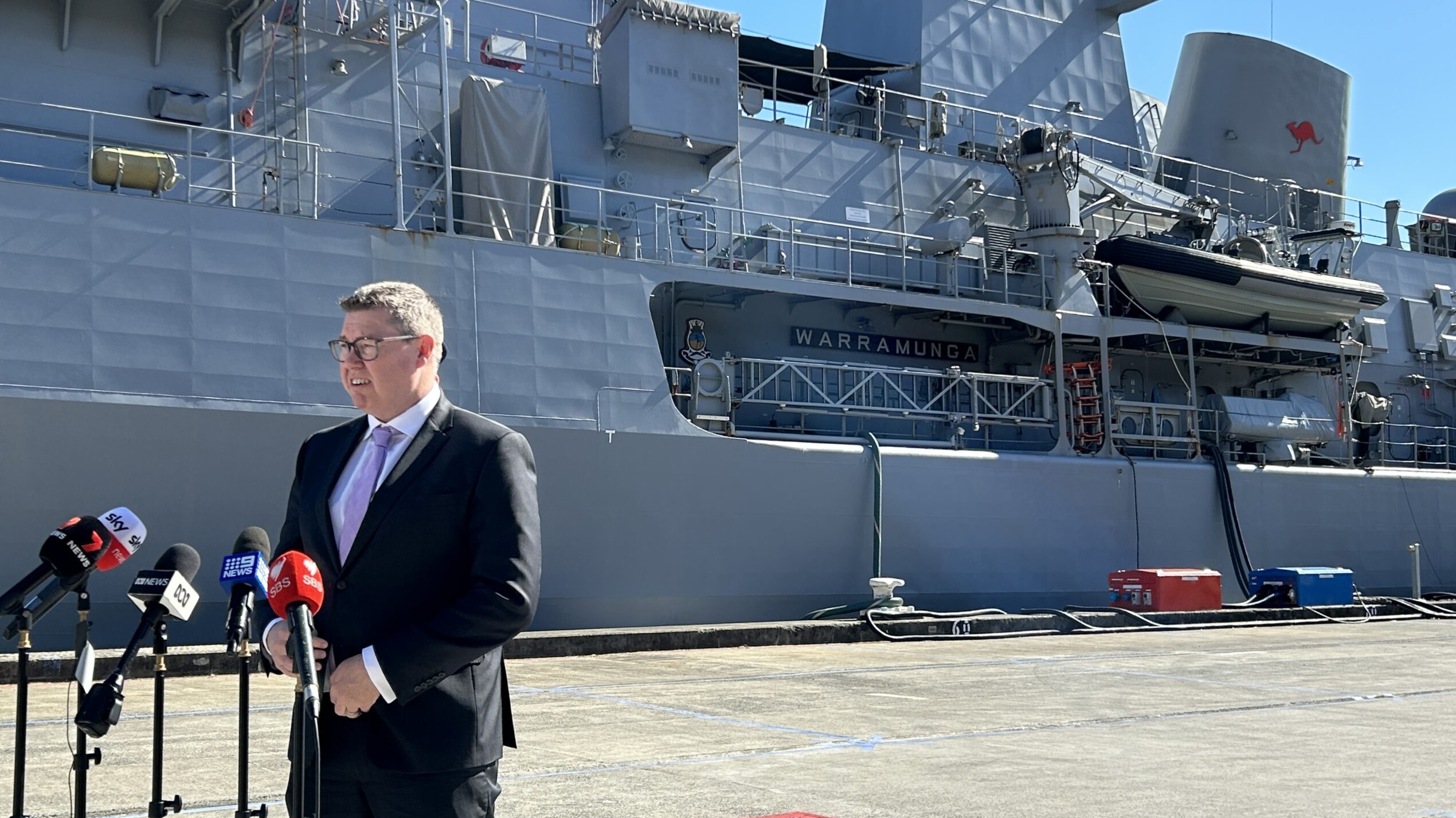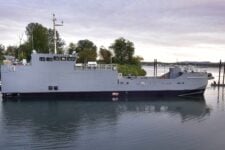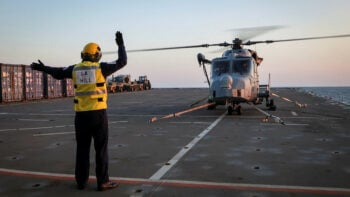
Pat Conroy, Australian defense industry minister, takes press questions about long-range missile purchases in front of HMAS Warramunga, berthed in Sydney. (Colin Clark/Breaking Defense)
SYDNEY — Three days before the defense ministers of AUKUS are gathering in California, the Australian minister for defense industry, Pat Conroy, offered a full-throated defense of his government’s approach on the massive plan for Australia to buy at least three Virginia-class submarines and create a whole new class of subs to be known as SSN AUKUS.
The minister, speaking to reporters yesterday, also confirmed a number of details about the AUKUS plan and how Canberra will approach industrial participation for the tri-lateral agreement, which ties the US, UK and Australia together on miliary issues, most prominently with nuclear-powered submarines.
Repeating a familiar trope from the Defense Strategic Review and speeches by Defense Minister Richard Marles, Conroy warned that the government’s “10-year warning time has evaporated.” Today, he said, Australia “must be able to deter conflict before it begins and certainly before it reaches our shores.”
The solution, Conroy said, is acquiring “a mix of intelligence collection, defensive and strike assets that generate deterrence.” And the key to that strategy is “acquiring the most capable nuclear-powered conventionally armed submarines in the world.”
Conroy confirmed officially that a version of Lockheed Martin’s combat system— used on all US and Australian attack subs currently sailing — will be used for the AUKUS class boats, expected to enter UK service in the late 2030s and Australian service in the early 2040s.
RELATED: ‘SSN AUKUS’: How the US and UK plan to get nuclear-powered subs to Australia
The combat system “will be an evolved version of the current AN/BYG-1 combat system, which is already in service in the Collins and Virginia-class submarines. This evolved version will be co-developed between Australia and the United States. It will incorporate evolutions of other existing systems that are tested, proven as successful, such as the vertical launch system and torpedo tubes,” Conroy said.
“It’s also envisaged to carry weapons deployed on US and Australian submarines such as the Mark 48 heavyweight torpedo,” also built by Lockheed, he said. “And sustainment needs are being considered from day one of the process, including what parts we will need, when we will need them and where they will need to be.”
Conroy also cleared up questions about production on the new subs, stating that the SSN AUKUS fleet’s hulls for Australia will be built here, not the UK. That’s pushback to statements from opposition politicians, who have claimed that Australia is going to miss out on the industrial windfall of AUKUS by not producing hulls here. (UK yards will still build the hulls for their own domestic boats, however.)
“The entire point of AUKUS Pillar 1 is to expand and grow the industrial base of all three nations so that Australia can join the US and UK in building nuclear-powered submarines,” Conroy stated.
“This means the AUKUS partners move from having three shipyards capable of building nuclear-powered submarines to four of these shipyards. It will be a transformative uplift in Australia’s defence and industrial capabilities and a net increase to our AUKUS partners’ industrial capabilities at a time when we need it most.”
While the plan’s outlines are coming into sharper focus, AUKUS is still a fragile, young program — and there are hurdles to overcome.
The budget discussion has not ended in any of the nations involved. Both the American and Australian legislatures must pass legislation allowing the sharing of highly sensitive submarine technology. Australia must find and build a facility to store radioactive waste from the submarines, considered by many to be the most politically and technologically difficult aspect of the program. And Australia must actually authorize and begin spending a substantial portion of the $365 billion the SSN AUKUS class is estimated to consume over its lifetime.
RELATED: Proposed Australian export law meant to help AUKUS sharing, but experts are sounding alarms
At the end of the week, US Defense Secretary Lloyd Austin will host Conroy’s boss, Defense Minister Richard Marles, and Grant Shapps, Britain’s minister for defence, at Silicon Valley’s Moffett Field, home to the Pentagon’s Defense Innovation Unit, to discuss the path ahead for the submarine program.
Disagreement Around Australian Defense Spending
Buying those subs will be the most expensive— an estimated $365 billion — and technologically complex enterprise Australia has ever engaged in, so budget and creating an entirely new industrial base will be key. Which is why a May publication from the Australian Strategic Policy Institute, stating the country will actually spend $1.5 billion less on defense over the next two years, caused ripples of concern in the Lucky Country.
Asked specifically about the report, Conroy essentially stated that he did not agree with the premise of the question. Conroy also accused ASPI “of picking and choosing between what parts (of the budget) they counted and what parts they didn’t count.”
In fact, he argued, “the defence budget goes up every year over the forward estimates. And as importantly, if you compare those years to what the last government projected in their last budget, which is March 2022, in every year of Labor’s budget they are higher than what the Opposition committed to when they were in government. So every year the defence budget goes up, and we’ll reach 2.3 per cent of GDP at the end of the decade, so over the 10 years, moving from just slightly over 2 per cent now.
“So I know people are frustrated,” Conroy said, “but the defence budget is increasing. Money is flowing to defence industry to deliver capable projects, critical capabilities.”
That statement was not felt by the more than half dozen industry sources who told Breaking Defense and other reporters during the recent Indo-Pac maritime conference that they are concerned about getting money for future investments. The “flow” of money was largely restricted to existing programs, maintenance and supply, they said, with little to no new money available since the Labor government of Anthony Albanese took power.






















